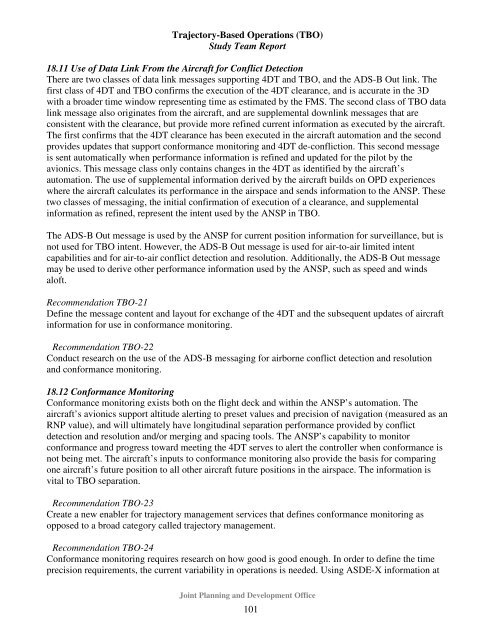Trajectory-Based Operations (TBO) - Joint Planning and ...
Trajectory-Based Operations (TBO) - Joint Planning and ...
Trajectory-Based Operations (TBO) - Joint Planning and ...
Create successful ePaper yourself
Turn your PDF publications into a flip-book with our unique Google optimized e-Paper software.
<strong>Trajectory</strong>-<strong>Based</strong> <strong>Operations</strong> (<strong>TBO</strong>)<br />
Study Team Report<br />
18.11 Use of Data Link From the Aircraft for Conflict Detection<br />
There are two classes of data link messages supporting 4DT <strong>and</strong> <strong>TBO</strong>, <strong>and</strong> the ADS-B Out link. The<br />
first class of 4DT <strong>and</strong> <strong>TBO</strong> confirms the execution of the 4DT clearance, <strong>and</strong> is accurate in the 3D<br />
with a broader time window representing time as estimated by the FMS. The second class of <strong>TBO</strong> data<br />
link message also originates from the aircraft, <strong>and</strong> are supplemental downlink messages that are<br />
consistent with the clearance, but provide more refined current information as executed by the aircraft.<br />
The first confirms that the 4DT clearance has been executed in the aircraft automation <strong>and</strong> the second<br />
provides updates that support conformance monitoring <strong>and</strong> 4DT de-confliction. This second message<br />
is sent automatically when performance information is refined <strong>and</strong> updated for the pilot by the<br />
avionics. This message class only contains changes in the 4DT as identified by the aircraft’s<br />
automation. The use of supplemental information derived by the aircraft builds on OPD experiences<br />
where the aircraft calculates its performance in the airspace <strong>and</strong> sends information to the ANSP. These<br />
two classes of messaging, the initial confirmation of execution of a clearance, <strong>and</strong> supplemental<br />
information as refined, represent the intent used by the ANSP in <strong>TBO</strong>.<br />
The ADS-B Out message is used by the ANSP for current position information for surveillance, but is<br />
not used for <strong>TBO</strong> intent. However, the ADS-B Out message is used for air-to-air limited intent<br />
capabilities <strong>and</strong> for air-to-air conflict detection <strong>and</strong> resolution. Additionally, the ADS-B Out message<br />
may be used to derive other performance information used by the ANSP, such as speed <strong>and</strong> winds<br />
aloft.<br />
Recommendation <strong>TBO</strong>-21<br />
Define the message content <strong>and</strong> layout for exchange of the 4DT <strong>and</strong> the subsequent updates of aircraft<br />
information for use in conformance monitoring.<br />
Recommendation <strong>TBO</strong>-22<br />
Conduct research on the use of the ADS-B messaging for airborne conflict detection <strong>and</strong> resolution<br />
<strong>and</strong> conformance monitoring.<br />
18.12 Conformance Monitoring<br />
Conformance monitoring exists both on the flight deck <strong>and</strong> within the ANSP’s automation. The<br />
aircraft’s avionics support altitude alerting to preset values <strong>and</strong> precision of navigation (measured as an<br />
RNP value), <strong>and</strong> will ultimately have longitudinal separation performance provided by conflict<br />
detection <strong>and</strong> resolution <strong>and</strong>/or merging <strong>and</strong> spacing tools. The ANSP’s capability to monitor<br />
conformance <strong>and</strong> progress toward meeting the 4DT serves to alert the controller when conformance is<br />
not being met. The aircraft’s inputs to conformance monitoring also provide the basis for comparing<br />
one aircraft’s future position to all other aircraft future positions in the airspace. The information is<br />
vital to <strong>TBO</strong> separation.<br />
Recommendation <strong>TBO</strong>-23<br />
Create a new enabler for trajectory management services that defines conformance monitoring as<br />
opposed to a broad category called trajectory management.<br />
Recommendation <strong>TBO</strong>-24<br />
Conformance monitoring requires research on how good is good enough. In order to define the time<br />
precision requirements, the current variability in operations is needed. Using ASDE-X information at<br />
<strong>Joint</strong> <strong>Planning</strong> <strong>and</strong> Development Office<br />
101
















